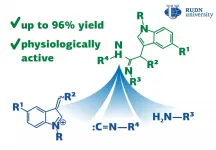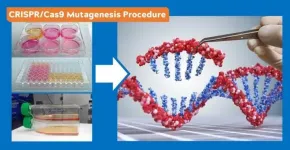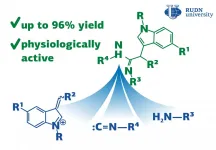(Press-News.org) To date, there are no effective antidotes against most virus infections. An interdisciplinary research team at the Technical University of Munich (TUM) has now developed a new approach: they engulf and neutralize viruses with nano-capsules tailored from genetic material using the DNA origami method. The strategy has already been tested against hepatitis and adeno-associated viruses in cell cultures. It may also prove successful against corona viruses.
There are antibiotics against dangerous bacteria, but few antidotes to treat acute viral infections. Some infections can be prevented by vaccination but developing new vaccines is a long and laborious process.
Now an interdisciplinary research team from the Technical University of Munich, the Helmholtz Zentrum München and the Brandeis University (USA) is proposing a novel strategy for the treatment of acute viral infections: The team has developed nanostructures made of DNA, the substance that makes up our genetic material, that can trap viruses and render them harmless.
DNA nanostructures
Even before the new variant of the corona virus put the world on hold, Hendrik Dietz, Professor of Biomolecular Nanotechnology at the Physics Department of the Technical University of Munich, and his team were working on the construction of virus-sized objects that assemble themselves.
In 1962, the biologist Donald Caspar and the biophysicist Aaron Klug discovered the geometrical principles according to which the protein envelopes of viruses are built. Based on these geometric specifications, the team around Hendrik Dietz at the Technical University of Munich, supported by Seth Fraden and Michael Hagan from Brandeis University in the USA, developed a concept that made it possible to produce artificial hollow bodies the size of a virus.
In the summer of 2019, the team asked whether such hollow bodies could also be used as a kind of "virus trap". If they were to be lined with virus-binding molecules on the inside, they should be able to bind viruses tightly and thus be able to take them out of circulation. For this, however, the hollow bodies would also have to have sufficiently large openings through which viruses can get into the shells.
"None of the objects that we had built using DNA origami technology at that time would have been able to engulf a whole virus - they were simply too small," says Hendrik Dietz in retrospect. "Building stable hollow bodies of this size was a huge challenge."
The kit for a virus trap
Starting from the basic geometric shape of the icosahedron, an object made up of 20 triangular surfaces, the team decided to build the hollow bodies for the virus trap from three-dimensional, triangular plates.
For the DNA plates to assemble into larger geometrical structures, the edges must be slightly beveled. The correct choice and positioning of binding points on the edges ensure that the panels self-assemble to the desired objects.
"In this way, we can now program the shape and size of the desired objects using the exact shape of the triangular plates," says Hendrik Dietz. "We can now produce objects with up to 180 subunits and achieve yields of up to 95 percent. The route there was, however, quite rocky, with many iterations."
Viruses are reliably blocked
By varying the binding points on the edges of the triangles, the team's scientists can not only create closed hollow spheres, but also spheres with openings or half-shells. These can then be used as virus traps.
In cooperation with the team of Prof. Ulrike Protzer, head of the Institute for Virology at TUM and director of the Institute for Virology at the Helmholtz Zentrum München, the team tested the virus traps on adeno-associated viruses and hepatitis B virus cores.
"Even a simple half-shell of the right size shows a measurable reduction in virus activity," says Hendrik Dietz. "If we put five binding sites for the virus on the inside, for example suitable antibodies, we can already block the virus by 80 percent, if we incorporate more, we achieve complete blocking."
To prevent the DNA particles from being immediately degraded in body fluids, the team irradiated the finished building blocks with UV light and treated the outside with polyethylene glycol and oligolysine. The particles were thus stable in mouse serum for 24 hours.
A universal construction principle
Now the next step is to test the building blocks on living mice. "We are very confident that this material will also be well tolerated by the human body," says Dietz.
"Bacteria have a metabolism. We can attack them in different ways, " says Prof. Ulrike Protzer. "Viruses, on the other hand, do not have their own metabolism, which is why antiviral drugs are almost always targeted against a specific enzyme in a single virus. Such a development takes time. If the idea of simply mechanically eliminating viruses can be realized, this would be widely applicable and thus an important breakthrough, especially for newly emerging viruses.
The starting materials for the virus traps can be mass-produced biotechnologically at a reasonable cost. "In addition to the proposed application as a virus trap, our programmable system also creates other opportunities," says Hendrik Dietz. "It would also be conceivable to use it as a multivalent antigen carrier for vaccinations, as a DNA or RNA carrier for gene therapy or as a transport vehicle for drugs."
INFORMATION:
The research was funded by the European Community's Horizon 2020 Research and Innovation Program under the FET-Open project VIROFIGHT (grant no. 899619), the European Research Council (ERC) under a Consolidator Grant, the German Research Foundation (DFG) through SFB863 and TRR179, and by grants of the Gottfried Wilhelm Leibniz Program, the German Federal Ministry of Education and Research (BMBF) through the StabVacB project and the German Center for Infection Research (DZIF), the Netherlands Organization for Scientific Research (NWO), the National Science Foundation of the USA via the Brandeis University Materials Research Science and Engineering Center, the National Institute of General Medical Sciences (NIGMS) of the USA, and the Alexander von Humboldt Foundation (AvH).
A new study finds that resilience is a dynamic process, rather than a fixed trait - and suggests this may have significant ramifications for the business world.
"Organizations are interested in cultivating a resilient workforce, because they want people who are able to remain committed to an organization and its goals over time," says Patrick Flynn, corresponding author of the study and an assistant professor of human resources management at North Carolina State University's Poole College of Management.
"Our work here does a couple things," Flynn says. "First it finds that resilience is more of a process than a characteristic. Second, it identifies some of the ...
RUDN University chemists obtained a metal-containing complex with an unusual planar architecture. The unexpected structure was formed due to the spontaneous fixation of carbon dioxide from the air during the reaction. This compound exhibits unusual magnetic properties (spin glass behaviour). This can be useful for creating memory storage devices. The results are published in the Journal of Organometallic Chemistry
Coordination polymers are hybrid crystalline coordination compounds contained of infinitely repeating fragments (structural elements). These structural ...
The mitochondrion has garnered quite the reputation for its role as the "powerhouse of the cell." These tiny, but mighty organelles play various life-sustaining roles, from powering our own cells and organs to fueling chemical and biological processes. But when they aren't working properly, a number of rare diseases can occur.
Mitochondrial diseases are a group of debilitating genetic disorders that affect one in 5,000 people throughout the world, most of them being children. Along with these diseases come a variety of health concerns including, but not limited to, heart ...
The pandemic has taught us that almost all companies have to sell on the internet. Bots are a technology that facilitates e-commerce. They are digital assistants that can answer customer queries about products that are sold or help to locate them, as well as supporting customers in the purchasing process. "In whatever language; and moreover, chatbots never get tired: They're available 24 hours a day, 365 days a year", said Jordi Cabot, the Universitat Oberta de Catalunya (UOC) researcher who created Xatkit, a company specialized in their development. This technology has existed for some time in big companies and is now also helping improve the digital competitiveness ...
The RUDN University chemists have discovered a reaction for the synthesis of acetimidamides, heterocyclic compounds with biological activity that can be used for the synthesis of hormones, anti-inflammatory and other medical drugs. The reaction goes in one step with an efficiency of up to 96%. The results are published in the journal Molecules.
Traditional chemical synthesis goes in several stages and requires the isolation and purification of intermediates at each stage. It is not efficient and not environmentally friendly as it increases the loss of substances and the consumption of solvents, and there is a problem of waste disposal. ...
Scientists have uncovered a way to control many genes in engineered yeast cells, opening the door to more efficient and sustainable production of bio-based products.
The study, published in Nucleic Acids Research by researchers from DSM's Rosalind Franklin Biotechnology Center in Delft, the Netherlands, and the University of Bristol, has shown how to unlock CRISPR's potential for regulating many genes simultaneously.
Baker's yeast, or Saccharomyces cerevisiae to give it it's full name, is considered as a workhorse for biotechnology. Not only has it been used for producing bread and beer for thousands of years, but today it can also be engineered to produce an array of other useful compounds that form the basis of pharmaceuticals, fuels, and food additives. However, achieving ...
According to the World Health Organization, a third wave of COVID infections is now all but inevitable in Europe. A COVID tracker developed by IIASA researcher Asjad Naqvi, aims to identify, collect, and collate various official regional datasets for European countries, while also combining and homogenizing the data to help researchers and policymakers explore how the virus spreads.
While many comparisons have been made between the COVID-19 pandemic and similar events in history, one thing sets this pandemic apart from others: the unprecedented amount of knowledge and data that is constantly being generated to understand how the pandemic is unfolding. For a high-income region like Europe, the quality of information made available on a daily basis is exceptionally ...
The Institut Pasteur, in partnership with the French National Health Insurance Fund (CNAM), Santé publique France and the Ipsos Social Research Institute, recently presented the results of the ComCor epidemiological study on circumstances and places of infection with the SARS-CoV-2 virus. The aim of the study was to identify the socio-demographic factors, places visited and behaviors associated with a higher risk of infection with SARS-CoV-2. The study contains two parts:
the first part describes the circumstances of infection of index cases diagnosed positive for SARS-CoV-2 during the curfew period, especially when the person considered as the source of infection is known;
the ...
PHILADELPHIA - People who struggle with serious mental illnesses are more likely to die early - about 10 to 30 years early - than those without mental illness from any cause. Many factors contribute to this disparity including poor access to care, undetected health conditions and difficulty managing chronic health conditions. Addressing physical illness in those with serious mental illness has been a major challenge. To address this, researchers tested a peer-led intervention called the Bridge that helps patients with mental illness prioritize their health, access health care and develop skills to self-manage their health. The approach showed a 50% reduction in emergency room use for those in ...
University of Otago scientists have opened the door to improved treatment of brain dysfunction which causes psychosis.
Dr Ryan Ward, of the Department of Psychology, says he and a team of researchers have been working on ways to model schizophrenia symptoms in animal models.
"Psychosis is a debilitating aspect of schizophrenia and, while current drugs treat it well, they have horrendous side effects which lead to poor quality of life for patients. Research which can identify specific mechanisms of the dysfunction can provide more precise drug targets for treatment, improving patient ...



